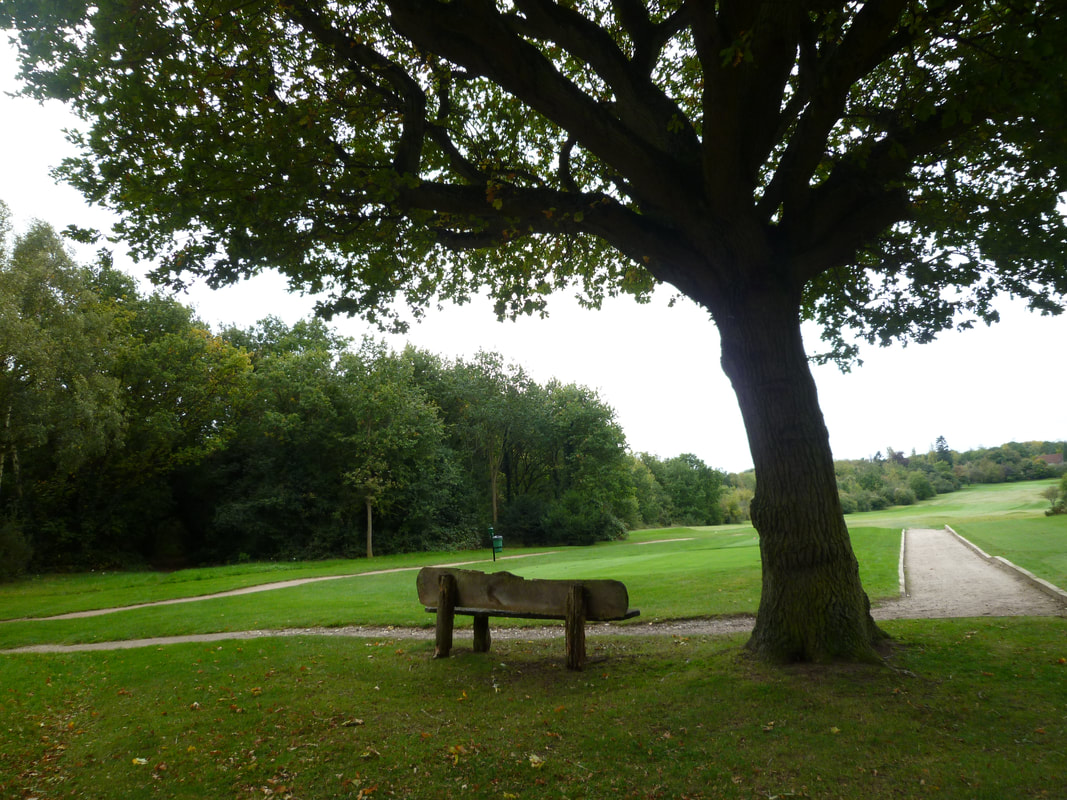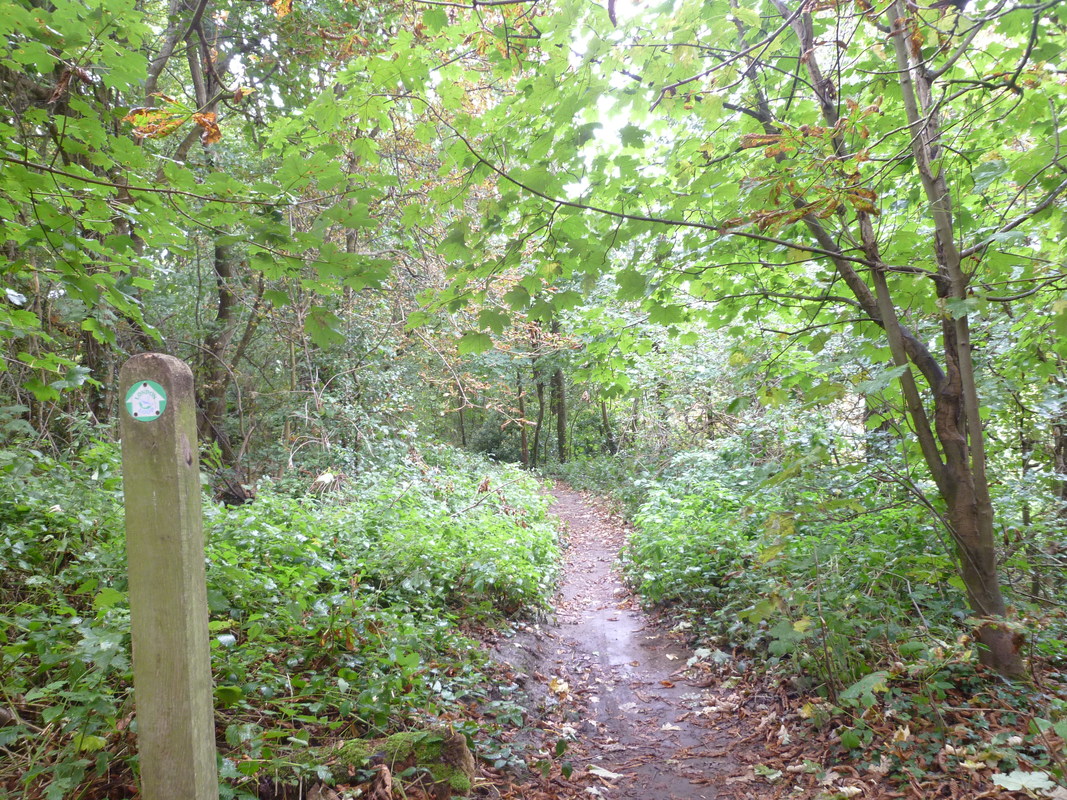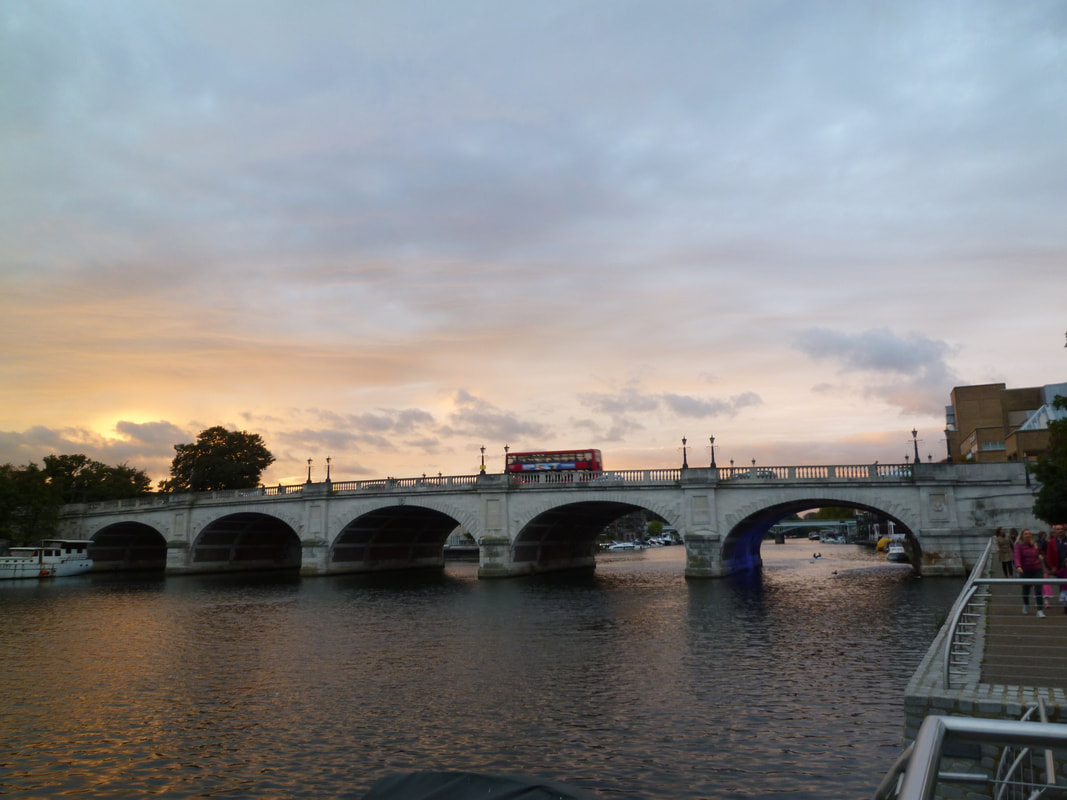The London Loop
Banstead Downs to Kingston Bridge
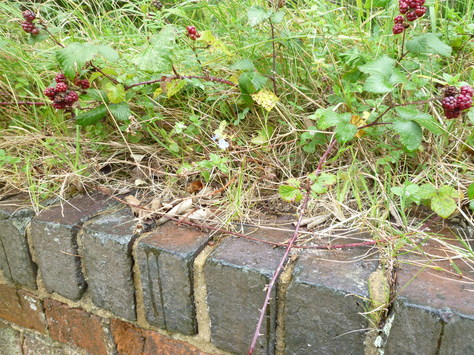
Saturday 7 October 2017
Travelling to Banstead is not straightforward. Today I chose a different route (via Clapham Junction rather than central London) and quite enjoyed the experience despite a travel time of more than three hours. My tip is to always take a good book to read. Makes waiting for a train so much more bearable.
Arriving in Banstead I was soon back on The Loop. Not sure how I managed to lose my way at the end of the previous section. Today I found the link path through the golf course clearly waymarked and straightforward. After the golf course there was a long and tedious stretch of road walking. I was questioning my sanity. Why travel for hours to go on a walk through London suburbia? However, here I was, and one positive of roadside walking is the opportunity to walk quickly and eat up some miles! I also recalled my belief that even the dullest surroundings have something to offer. Cheerfully walking on, even when a nuisance of a drizzle accompanied me, I passed a garden, full of not only flowers of all colours, but a chaos of ornaments and gnomes to confirm that this walk is worthwhile!
Soon I passed through a tunnel into Warren Farm, a green space managed by the Woodland Trust. As the drizzle turned into rain I arrived at Nonsuch Park, the site where Henry VIII once built an exotic palace. There is nothing left of the palace but Nonsuch Mansion (built in 1804) with its gardens, café and toilets would make a good diversion, time permitting. The rain thankfully soon eased off. I walked on the edge of the park, sheltered by the large oak, beech and chestnut trees. The park was busy with cyclists and walkers and I was pleased to see the sun make a welcome appearance. The Loop continued along a pleasant woodland path which followed a series of waymark pillars. Emerging from the trees, a low brick wall was all that was left of the Nonsuch Banqueting Hall, a hunting lodge which was part of Henry VIII’s Nonsuch estate.
Travelling to Banstead is not straightforward. Today I chose a different route (via Clapham Junction rather than central London) and quite enjoyed the experience despite a travel time of more than three hours. My tip is to always take a good book to read. Makes waiting for a train so much more bearable.
Arriving in Banstead I was soon back on The Loop. Not sure how I managed to lose my way at the end of the previous section. Today I found the link path through the golf course clearly waymarked and straightforward. After the golf course there was a long and tedious stretch of road walking. I was questioning my sanity. Why travel for hours to go on a walk through London suburbia? However, here I was, and one positive of roadside walking is the opportunity to walk quickly and eat up some miles! I also recalled my belief that even the dullest surroundings have something to offer. Cheerfully walking on, even when a nuisance of a drizzle accompanied me, I passed a garden, full of not only flowers of all colours, but a chaos of ornaments and gnomes to confirm that this walk is worthwhile!
Soon I passed through a tunnel into Warren Farm, a green space managed by the Woodland Trust. As the drizzle turned into rain I arrived at Nonsuch Park, the site where Henry VIII once built an exotic palace. There is nothing left of the palace but Nonsuch Mansion (built in 1804) with its gardens, café and toilets would make a good diversion, time permitting. The rain thankfully soon eased off. I walked on the edge of the park, sheltered by the large oak, beech and chestnut trees. The park was busy with cyclists and walkers and I was pleased to see the sun make a welcome appearance. The Loop continued along a pleasant woodland path which followed a series of waymark pillars. Emerging from the trees, a low brick wall was all that was left of the Nonsuch Banqueting Hall, a hunting lodge which was part of Henry VIII’s Nonsuch estate.
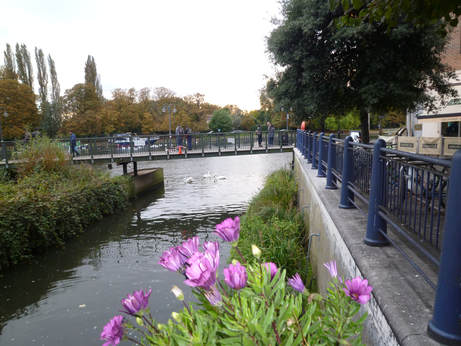
Now the roar of traffic brought me back to modern day reality and as the Ewell bypass came into view, I approached it with trepidation, knowing I had to cross it! There was so much traffic speeding past that I thought at first that I would never be able to cross but luckily the traffic lights further up led to a large gap in traffic and I safely arrived in Ewell. Plenty of interesting buildings, e.g. a medieval church tower and Ewell Castle (now a school) lined the route. I resisted the lure of the High Street and headed straight to Bourne Hill Park, entering through the impressive Dog Gate. The path now continued along a pretty lake, home to the usual large number of well-fed ducks, swans and geese of urban park ponds. This lake and several others in the vicinity are the source springs of the river Hogsmill and the path now followed the river all the way to Kingston. Before continuing the walk, I stopped at the futuristic, flying saucer shaped Bourne Hall, a community centre and library with a café and toilets, for a welcome cup of tea and scone.
The walk along the Hogsmill almost felt like a countryside ramble. Trees screened out any intruding buildings and water meadows lined parts of the route. By the time the Loop joined another long-distance route, the Thames Down Link, the river had increased in size and the scenery had become more urban. The trees made way for sports fields, a go-karting track and schools. The path then briefly diverted away from the river, going uphill, past St John the Baptist church at Old Malden, and then downhill again on a mixture of footpaths and roads to re-join the river. After crossing a busy dual carriageway (via a subway) the Hogsmill River Path Nature Reserve provide pleasant walking through woodland and meadows. At Berrylands the Loop joined a cycle route and continued uninspiringly past industrial plants and a cemetery, away from the river. Quite tedious really, until a fox, oblivious to my presence, crossed the path right in front of me to provide a welcome diversion.
Arriving in Kingston, the Hogsmill river reappeared. I followed it past the Guildhall, crossed it one more time on the Clattern Bridge, and accompanied it all the way to its glamorous ending as it flowed into the Thames. The riverside restaurants and bars started filling up as the sun made a belated appearance, setting beautifully beyond Kingston Bridge.
The walk along the Hogsmill almost felt like a countryside ramble. Trees screened out any intruding buildings and water meadows lined parts of the route. By the time the Loop joined another long-distance route, the Thames Down Link, the river had increased in size and the scenery had become more urban. The trees made way for sports fields, a go-karting track and schools. The path then briefly diverted away from the river, going uphill, past St John the Baptist church at Old Malden, and then downhill again on a mixture of footpaths and roads to re-join the river. After crossing a busy dual carriageway (via a subway) the Hogsmill River Path Nature Reserve provide pleasant walking through woodland and meadows. At Berrylands the Loop joined a cycle route and continued uninspiringly past industrial plants and a cemetery, away from the river. Quite tedious really, until a fox, oblivious to my presence, crossed the path right in front of me to provide a welcome diversion.
Arriving in Kingston, the Hogsmill river reappeared. I followed it past the Guildhall, crossed it one more time on the Clattern Bridge, and accompanied it all the way to its glamorous ending as it flowed into the Thames. The riverside restaurants and bars started filling up as the sun made a belated appearance, setting beautifully beyond Kingston Bridge.
My highlights:
Transport:
- Nonsuch Park
- Ewell (the village and Bourne Hill Park)
- Early section of the Hogsmill riverside path
- Kingston (where the Hogsmill River flows into the Thames)
- Birds, ducks and swans
- Squirrels
- Fox
Transport:
- Train Reading to Banstead (changing at Clapham Junction, Wimbledon and Sutton)
- Return: Train Kingston to Reading (changing at Twickenham)
- Train stations (apart from Banstead)
- Ewell
- Kingston
- Train stations
- Library/café at Bourne Hill Park
